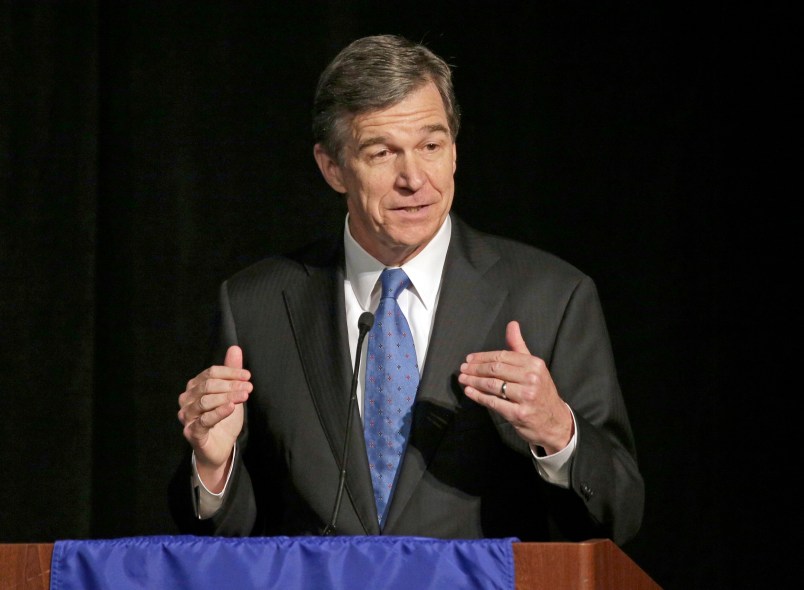RALEIGH, N.C. (AP) — North Carolina Democrats say they are beginning 2018 energized and intent on regaining their historical control of the state’s General Assembly, harnessing anger over Republican Donald Trump’s presidency and buoyed by Democratic victories elsewhere.
Eager to reassert their longtime influence on North Carolina politics, the Democrats already have already fielded an unusually large pool of candidates for 100 seats in the 170-member bicameral legislature. Though official candidate filing doesn’t start until mid-February, the Democrats are quickly approaching the number of House and Senate seats they contested in 2016 and hope to strongly contest each seat in November.
Republicans used a similar full-court candidate strategy in 2010 to seize control of both chambers for the first time in 140 years. They’ve held veto-proof majorities since 2013, allowing them to impose a right-leaning agenda including broad tax cuts, abortion restrictions and taxpayer-funded grants for children to attend private schools. They also passed the state’s “bathroom bill,” later partially repealed. While Democrats regained a bully pulpit when Gov. Roy Cooper narrowly defeated GOP incumbent Pat McCrory in 2016, they’ve still been unable to stop the GOP agenda because most of the Democratic governor’s vetoes were overridden.
Republicans, well-honed in their own campaign operations, acknowledge the Democrats’ momentum but point out November is months away. They say their record of cutting taxes and regulations has paid dividends through economic growth and low jobless rates. But that’s not deterring newcomers, who are raising their hands for the Democrats well before all 50 Senate seats and all 120 House seats go up for grabs Nov. 6.
The 2016 election, including Trump’s victory, “was pretty much a wake-up call and I just could not rely on other people to represent what I think is important,” said Terri LeGrand, a first-time state House candidate from Winston-Salem. “The current leadership in Raleigh has had the wrong priorities on lowering taxes, instead of investing in the future.” While Trump won the South in 2016 save for Virginia, his margin over Hillary Clinton in North Carolina was less than 4 percentage points.
Cooper has been raising funds for Democratic attempts to win back both chambers by 2020. The state’s party is optimistic: Democrats surged in neighboring Virginia’s state House races in November, erasing a large GOP majority. He predicted in an interview with The Associated Press there will be a similar Democratic surge next November, bring about a “more balanced legislature and thus better government.”
“People are frustrated with the Republican leadership in the North Carolina General Assembly, they’re frustrated with the administration in Washington and they’re ready for candidates who care about education and health care and the middle class,” Cooper said.
With the GOP holding a 75-45 majority in the North Carolina House and 35-15 Senate advantage, Democrats would need to flip 16 House seats and 11 Senate seats in November to take back the General Assembly. Ending veto-proof majorities, which would force Republicans to negotiate with Cooper and some Democrats on some issues, would require only four House seats or six Senate seats. All legislators serve two-year terms.
Rep. Graig Meyer of Orange County said the party is well on its way to fielding candidates for all 120 House seats. “Recruitments definitely got easier after Virginia,” said Meyer, who is helping to recruit candidates like LeGrand through the state party’s new “Pipeline Project.” Meyer and others have highlighted new female and LGBT candidates.
But Republicans say they’ll also have a strong field — and a strong record to run on.
“By the time we get to filing we’ll have a number of good candidates all across the board,” promised GOP Rep. John Szoka of Cumberland County, who is recruiting House Republican candidates. “What we have to offer the electorate is not rhetoric, but results.”
Senate leader Phil Berger anticipates Republicans will retain their veto-proof majority in his chamber. “North Carolina is not Virginia,” he added, pointing to more favorable Senate districts where Trump won in 2016.
North Carolina’s 13 U.S. House seats are also on the November ballots, but no U.S. Senate that would otherwise bring in tens of millions of dollars in campaign ads statewide.
North Carolina political consultants from both parties said in interviews that 2018 election outcomes will rest on registered unaffiliated voters. In 2017, that group became the state’s second largest voter bloc, surpassing Republicans. Democrats still remain at the top, though their share has fallen of late.
Dr. Rick Foulke of Waxhaw, a retired oncologist and another first-time state House candidate, knows what it’s like to be an unaffiliated voter. He was one until he switched his registration to a Democrat amid unhappiness with Republican lawmakers, particularly on redistricting favoring the GOP and their refusal to expand Medicaid to the state’s working poor.
Those and other Republican policies “got me off the sidelines and persuaded me that I really need to be in this fight,” Foulke said.







It would not surprise me in the least if NC turns very blue this year.
That’s a deep hole for Dems to dig out of, but I am hopeful. If Dems by some miracle get both houses, I want them to move immediately to redistrict the state in 2019 without waiting for the results of the 2020 census. This should be the standard play from now on when Dems take back legislatures after the GOP has redistricted to its advantage. Now, whether they use a “non-partisan” plan or a Dem-favorable plan is something else to be discussed.
First priority should be expanding Medicaid; Tar Heels are suffering and dying for literally no reason other than spite.
So which redistricting map gets used for 2018? The surgical strike one or something else?
The courts will decide.